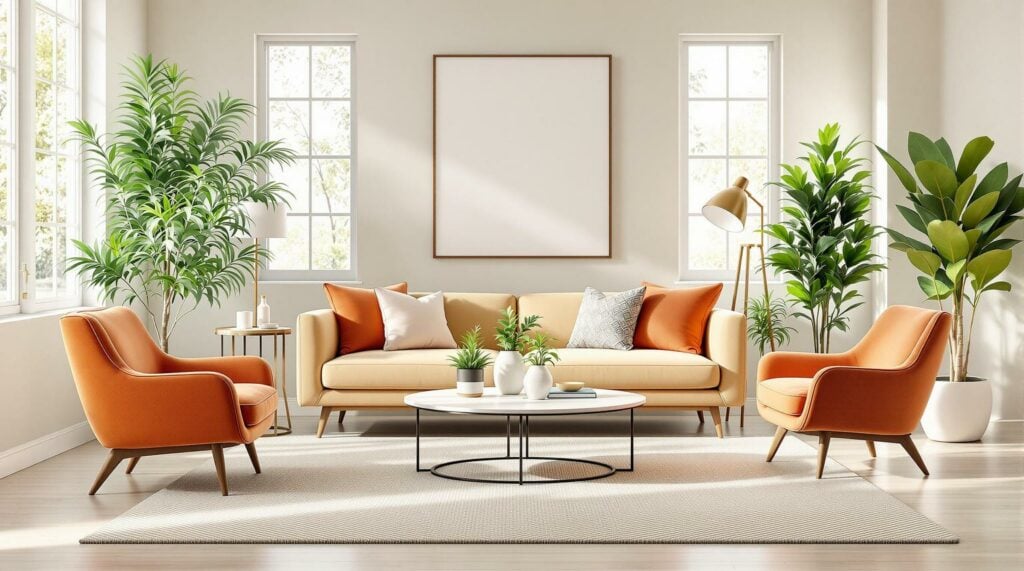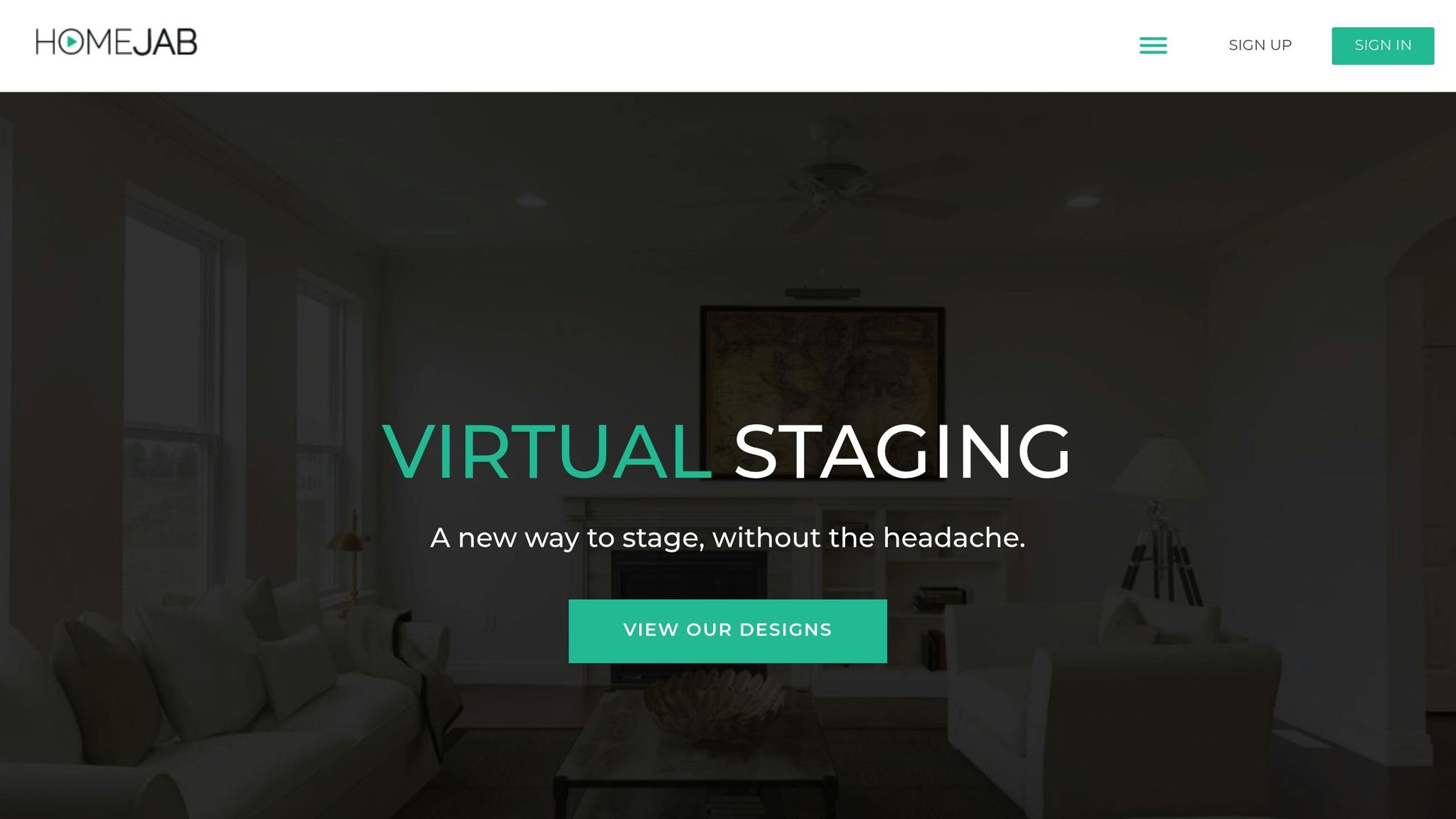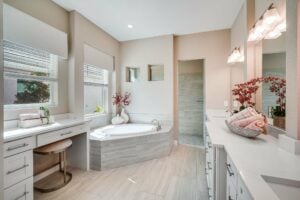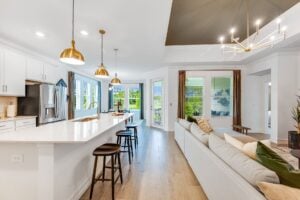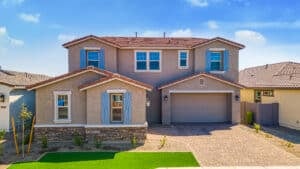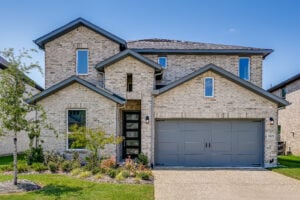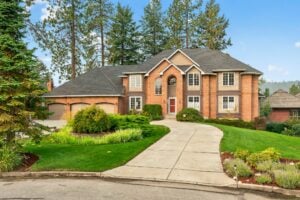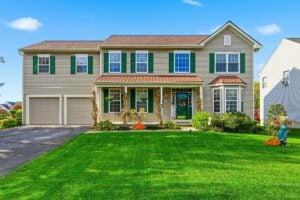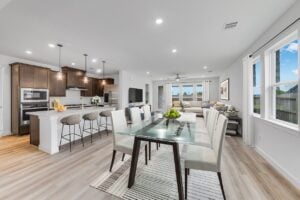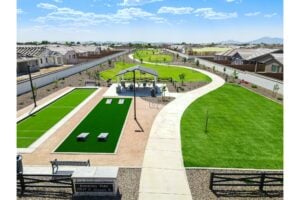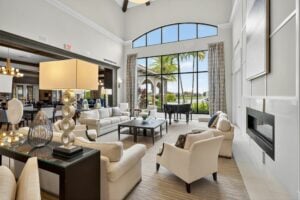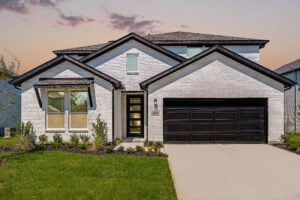Virtual staging transforms empty real estate spaces into inviting homes by digitally adding furniture and décor. It helps buyers visualize room layouts, dimensions, and flow, making properties more appealing and easier to sell. Here’s how to make virtual staging effective:
- Key Furniture Placement Rules:
- Keep 18 inches between sofas and coffee tables.
- Ensure 36 inches of clearance around dining tables.
- Bedrooms need 24-36 inches of space around beds for easy movement.
- Focus on Focal Points:
- Highlight features like fireplaces or scenic windows.
- Balance furniture placement to maintain visual harmony.
- Traffic Flow:
- Main pathways should be 36 inches wide.
- Use furniture to define zones in open spaces without disrupting flow.
- Styling for Target Markets:
- Modern properties suit minimalist furniture with clean lines.
- Classic homes benefit from wood furniture and traditional designs.
- Use neutral colors (60%), secondary tones (30%), and accents (10%) for balance.
- Make It Realistic:
- Match lighting and shadows.
- Align furniture perspective with the room’s architecture.
- Add décor like rugs and wall art to enhance the space.
HomeJab’s virtual staging service offers quick, professional results for $50 per photo, turning empty rooms into visually compelling spaces in just 24 hours. Start by uploading photos, selecting furniture styles, and approving the final images to boost your listings’ appeal.
TOP Virtual Staging HACK for Real Estate Photos
Basic Rules for Furniture Placement
Virtual furniture placement relies on key design principles to create visually appealing and functional spaces. HomeJab’s virtual staging experts stick to specific guidelines to make rooms look realistic, inviting, and practical.
Size and Space Requirements
Proper furniture sizing is the foundation of successful staging. For example, living rooms should have at least 18 inches between a coffee table and sofa. Dining rooms need a minimum of 36 inches of clearance around the table to ensure comfortable seating. Aim to have main furniture occupy about 60% of the floor space, leaving the remaining 40% for movement.
When dealing with larger pieces like sectional sofas or entertainment centers, maintain a 7-10 foot distance between seating and the TV for the best viewing experience. Bedrooms also have specific sizing needs:
- Queen bed (60 x 80 inches): Requires a minimum room size of 10 x 12 feet.
- King bed (76 x 80 inches): Needs at least 12 x 12 feet.
- Allow 24-36 inches of clearance around beds for easy navigation.
Once the furniture is sized correctly, the next step is to emphasize the room’s standout features.
Setting Room Focus Points
Focal points play a big role in directing attention and showcasing a room’s best aspects. For living rooms with fireplaces, arrange seating 8-15 feet from the hearth, angling the furniture slightly inward to encourage conversation. If the room has a scenic window view, arrange furniture to frame it rather than block it.
Here’s how to approach focal points:
- Primary focal point: Place the largest furniture piece to highlight a key architectural feature.
- Supporting elements: Use accent furniture and decor to complement the main focus.
- Balanced layout: Distribute visual weight evenly by offsetting large items with smaller ones.
Once the focal points are set, focus on creating smooth movement through the space.
Traffic Flow Planning
Good traffic flow keeps spaces open and accessible. Main pathways should be 36 inches wide, while secondary paths can be 24 inches wide. Arrange furniture to establish clear, defined routes between key areas.
For open-concept layouts, use furniture to define zones without disrupting flow:
- Place larger pieces along walls.
- Create natural pathways between functional zones.
- Keep 30-36 inches between furniture groupings.
- Avoid blocking doorways or windows with bulky items.
Design Choices for Target Markets
Matching furniture and design elements to a property’s architecture and buyer preferences is key to creating virtual staging that connects with your target audience.
Furniture Styles by Property Type
Different property types call for different furniture styles to highlight their best features:
- Modern properties like high-rise condos or urban lofts work well with contemporary furniture. Think clean lines, simple designs, and a minimalist approach. Ideal choices include:
- Multi-functional furniture for flexibility
- Low-profile seating to keep spaces feeling open
- Glass or metal accent pieces for a sleek finish
- Traditional homes shine with classic or transitional furniture that complements their architectural details. Focus on:
- Choosing furniture that’s appropriately scaled for the space
- Solid wood pieces that showcase craftsmanship
- Built-in features that enhance the home’s charm
To keep these styles relevant, incorporate design elements that reflect today’s preferences.
Current Design Elements
Modern virtual staging incorporates trends that buyers love. A few key elements include:
- Natural accents and live greenery for a fresh, inviting feel
- Flexible workspaces integrated into the design
- Layouts that accommodate smart home technology
- Eco-friendly furniture and sustainable materials
Each room should balance style and function to appeal to potential buyers:
| Room Type | Key Design Elements | Purpose |
|---|---|---|
| Living Room | Modular seating and natural textures | Adding comfort and versatility |
| Home Office | Desks with smart storage solutions | Supporting productivity |
| Kitchen | Functional seating and tech-friendly layouts | Improving efficiency |
Color Selection Guidelines
Color choices play a major role in creating visual appeal. A good starting point is a neutral base, complemented by secondary and accent colors. Stick to a 60-30-10 ratio:
- 60% dominant neutral tones
- 30% secondary colors for depth
- 10% vibrant accent colors for a pop of interest
HomeJab’s virtual staging tools ensure consistent color representation across marketing materials, helping properties attract a wide range of buyers while maintaining a cohesive look.
sbb-itb-82c5f45
Creating Natural-Looking Results
To make virtual staging look realistic, you need to focus on details like lighting, decor, and perspective. These elements work together to create a space that buyers can picture as their own. Here’s how to make sure each detail enhances the appeal of your staged photos.
Light and Shadow Effects
Lighting and shadows play a big role in making a room feel real. To get it right:
- Match shadows to the direction of visible light sources.
- Mimic how natural light behaves when it comes through windows.
- Use soft transitions for shadows to avoid harsh lines.
HomeJab’s virtual staging tech takes care of this by analyzing the room’s lighting and ensuring that added elements fit seamlessly into the photo.
Decor and Accent Placement
Smart placement of decor can define spaces and create balance. For example:
- Use area rugs to anchor seating areas.
- Add wall art and tabletop accents to create visual interest without cluttering the space.
- Keep sight lines clear to make the room feel open and inviting.
Correct View Angles
Perspective is key to making virtual furniture and decor look like they belong in the space. Here’s how to get it right:
- Align furniture angles with the room’s architectural features to match the original photo’s perspective.
- Use standard furniture dimensions to maintain the proper scale.
- Adjust for distortions caused by wide-angle lenses to keep everything looking natural.
HomeJab’s platform includes advanced tools that automatically match 3D furniture to the original photo’s view, making the results look seamless and lifelike.
HomeJab Virtual Staging Tools
HomeJab’s virtual staging platform makes it easy to place lifelike furniture in empty spaces, turning vacant properties into warm, welcoming homes. These tools help real estate professionals showcase properties in a way that helps potential buyers imagine living there.
HomeJab Service Features
HomeJab’s virtual staging service is designed to deliver high-quality results quickly and affordably. Here’s what you can expect:
- Fast turnaround: Receive your staged photos within just one business day.
- Professional results: Skilled designers ensure the furniture looks natural and fits the space perfectly.
- Affordable pricing: High-quality staging without breaking the budget.
Marketing Integration Options
HomeJab also offers additional tools to help you market properties more effectively. Here’s how you can make the most of their services:
- Complete Visual Package
Combine virtually staged photos with other visual tools such as:- HDR photography for vibrant, detailed images
- Walk-through videos to showcase the property’s layout
- 3D virtual tours for an immersive experience
- Aerial photography to highlight the property’s surroundings
- Digital Distribution
Simplify your marketing with features like:- MLS-ready photo formats included at no extra charge
- Branded property pages for a polished presentation
- High-resolution images optimized for online platforms
- Custom Solutions
Create a tailored package by combining services or scaling them to suit multiple properties.
Summary and Next Steps
Here’s how to make virtual staging work for you and turn empty spaces into homes that buyers can picture themselves in.
Virtual staging helps transform vacant rooms into warm, inviting spaces. The trick is to follow smart furniture placement practices and use professional virtual staging services for the best results.
Steps to Get Started:
- Start with Great Photos
Take high-quality HDR photos from the best angles. This ensures the final staged images look polished and professional. - Pick the Right Staging Style
Choose furniture and décor that match the property’s style, price range, and local market trends. Keep the design and space guidelines in mind. - Work with Virtual Staging Experts
Partner with HomeJab’s designers to create realistic images. They’ll handle scaling, lighting, and shadows to make everything look natural.
How to Use HomeJab for Virtual Staging
HomeJab has earned high customer ratings for consistently delivering quality results. Here’s how you can use their platform to enhance your property listings:
- Upload your property photos to HomeJab.
- Browse their furniture and décor options to find the perfect match.
- Approve the staged images and add them to your listings.
HomeJab offers virtual staging services for $50 per photo, with access to a wide range of furniture styles, expert design support, and a quick 24-hour turnaround. By following these steps and using professional services, you’ll create listings that stand out and help buyers imagine themselves living in the space. Virtual staging can make a big difference in reducing time on the market and boosting your property’s appeal.

